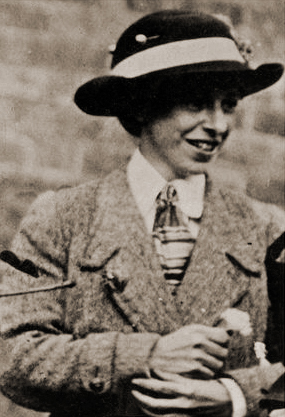Mary Richardson facts for kids
Quick facts for kids
Mary Richardson
|
|
|---|---|

by Special Branch circa 1912
|
|
| Born | 1882/3 |
| Died | 7 November 1961 Hastings, East Sussex, England
|
| Nationality | British |
| Occupation | Journalist |
| Known for | Slashing the Rokeby Venus |
Mary Raleigh Richardson (born around 1882 or 1883 – died November 7, 1961) was a Canadian woman who fought for women's right to vote. She was a key member of the women's suffrage movement in the United Kingdom. Later in her life, she became involved in politics, even running for a seat in Parliament. She also led the women's section of the British Union of Fascists, a political group.
Contents
Early Life and Travels
Mary Richardson grew up in a town called Belleville in Canada. When she was about 15 or 16 years old, in 1898, she traveled to exciting cities like Paris and places in Italy. Later, she lived in an area of London called Bloomsbury. While living there, she saw an important event in the suffrage movement known as Black Friday in 1910.
Fighting for Women's Votes
In the early 1900s, many women were frustrated because they did not have the same voting rights as men. To bring attention to this issue, the suffragette movement began to use stronger methods of protest. Mary Richardson was a very dedicated supporter of Emmeline Pankhurst, a famous leader of the suffragettes. Mary was a member of the Women's Social and Political Union (WSPU), a group known for its bold actions.
Mary Richardson believed she was at the Epsom races on June 4, 1913. This was the day Emily Davison, another suffragette, stepped in front of the King's horse. Emily Davison sadly died from her injuries. Mary Richardson later said she was chased by an angry crowd but found safety with a railway worker.
Mary Richardson took part in several protest actions. She broke windows at the Home Office and caused damage at a railway station. She was arrested nine times for her actions and spent more than three years in prison in total. She was one of the first women to be force-fed in prison when she went on hunger strike. She was then released to recover and later re-arrested under a law called the 1913 Cat and Mouse Act. For her bravery, the WSPU gave her a special Hunger Strike Medal.
The Rokeby Venus Incident
One of Mary Richardson's most famous acts of protest happened on March 10, 1914. She went to the National Gallery in London and attacked a famous painting called the Rokeby Venus by Velázquez. She used a small tool she had brought into the gallery.
She wrote a statement explaining why she did it, which was shared with the public. She said she damaged the painting, which showed a beautiful woman, to protest against the government. She felt the government was harming Mrs. Emmeline Pankhurst, whom she called "the most beautiful character in modern history." Mary believed that justice was as important as beauty in art. She argued that if people were upset about a painting being damaged, they should also be upset about the harm being done to Mrs. Pankhurst and other women fighting for justice.
Political Involvement
After her time as a suffragette, Mary Richardson became interested in other political ideas. In 1932, she joined the British Union of Fascists (BUF), a political group led by Sir Oswald Mosley. She felt that this group had the same courage, action, and loyalty she had seen in the suffragette movement. Mary quickly became an important leader in the BUF. By 1934, she was the Chief Organiser for the women's part of the party. However, she left the group within two years because she became disappointed with their policies regarding women.
Later Years
In 1930, Mary Richardson adopted a baby boy and named him Roger Robert Richardson. In 1953, she wrote a book about her life called Laugh a Defiance. Mary Richardson passed away in her home in Hastings on November 7, 1961.

